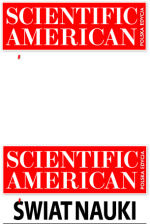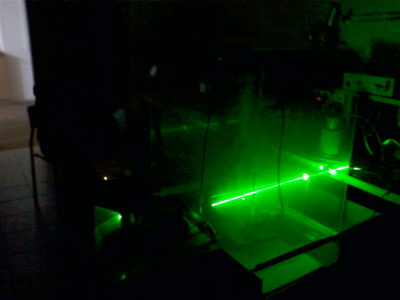 2006
2006
 2008
2008
 2010
2010
 2012
2012
 2014
2014



 |
Taming the fog
‘The influence of ultrasound on the velocity of fog’s drop’
Martyna Rachoń, Karolina Węgrzyńska – authors of photograph and project managers Fog’s descent with a speaker switched on inside |

|
Description popularizing the research project
Tinkering with weather phenomena, as it is widely known, is nothing good. There is a well-described example of Odysseus who got from Aeolus the gentle West Wind to let him sail home safely and a bag full of winds captured so that they could not disturb his journey. The winds freed by the greedy crew of Odysseus tossed his ship far away from the shores of Ithaca. So much says the myth. Yet atmospheric phenomena, so far inevitable, are the subject of stories, beliefs and scientific experiments. One of the most spectacular examples of an attempt to delve into the secrets of weather is ‘capturing’ a lightning in a Leyden jar according to the concept of Benjamin Franklin. It seems that it did not differ much from the story about Odysseus yet one of the results of the experiments is a, so much taken for granted, lightning rod.
In the eyes of the contemporaries, atmospheric phenomena are not so mysterious any more. The superstitions that associated thunderbolts and hurricanes with evil spirits are gone too. Nowadays winds, storms and hails are just inconveniences of everyday life generating economic losses. We all experience it when in a foggy morning commuting to work or school takes a few times longer than usual. The so far safe route is marked with crashed cars. It is usually nothing serious but surely troublesome a lot. City traffic deals badly with limited visibility. After a few hours, the problem solves itself but on the next day, it starts all over again. It is much worse in case of airports. Consequences of delayed and cancelled flights drag on for many days. Finding a way to disperse a fog quickly would prevent a lot of inconveniences and accidents. The experiments have quite a lot of in common with both Odysseus and Franklin, as they also require confining the element within laboratory vessels. Ultrasonic waves sound promising as they accelerate disappearing of the fog. Weather phenomena like disastrous twisters and troublesome window frost have been and probably will be accompanying us till the end of the world. Humanity used to live under the rule of weather conditions; today we are trying to tame them. Experience shows it does not have to be a utopia.
Abstract
In this project we were examining the thesis whether the fog in a form of a water vapor would drop quicker than independently under the influence of the ultrasound. If the time difference was proven to be substantial, it could solve problems at the airports and could have a wider application in motorization.
For the purposes of our experiment we created a unique, isolated medium with the greatest possible dimensions. By means of the humidifier we ordained the fog. We conducted alternate measurements of independent and supported with waves of different frequencies drop. For the measurement of thickness of the fog, we used a set of a green laser-diode that was plug into the computer. The computer gave measurable dependency of density and time. The ultrasounds were obtained from different sources: piezoelectric transducer, the speaker and ultrasonic cleaner. The state of the fog was tested with the use of a green laser (the wavelength of 532 nm) which was placed on one side of the medium (the box made of poly and then a glass jar) and the photodiode that received laser light was placed on the other side. A signal from the photodiode was converted by DAC and sent to our program running in Labview environment on a computer. The changes in the received data were visualized in a graph.
Our study shows that if the source of the ultrasound radiation is placed inside our isolated medium, then if the frequencies are higher the fog can drop even 25% faster in comparison with the independent drop. The limited amount of time precluded us from finishing the project. Due to a shortage of measurements we cannot be sure of the results of the research but we would like to improve the testing environment to improve accuracy of the further measurements.
Patronat honorowy
Leszek Jodliński
Dyrektor Muzeum Śląskiego w Katowicach
Zygmunt Łukaszczyk
Wojewoda Śląski
Jan Malicki
Biblioteka Śląska
Piotr Uszok
Prezydent Katowic
Adam Matusiewicz
Marszałek Województwa Śląskiego














